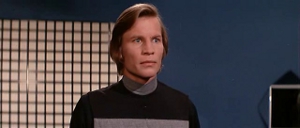
The mid-70s were a stranger time for SF films than most of us realize. Nowadays we see that pre-Star Wars decade through a screen called 2001: A Space Odyssey, forgetting how much that film (like Star Wars after it) polarized opinion, only assuming the status of Unassailable Classic after the stoned teenagers who loved it became filmmakers themselves. Before that, the Big Name in successful sci-fi films from 1968 was Planet of the Apes. Which deserves to be examined in its own time. So let’s just skim over its superficial attributes real fast.
Apes is a big budget ($5 million went a lot further back then) Major Studio SF picture based on a novel few bothered to read with a well-known piece of beefcake in the lead role and supporting actors doing much better jobs. So I’m not surprised William F. Nolan and George Clayton Johnson’s novel got its own time in the limelight. Logan’s Run-the-book hit shelves in 1967…the same year our beefcake, Michael York, hit screens in The Taming of the Shrew. By the time he won the lead in this big budget ($9 million) Major Studio SF picture, he’d become internationally famous as D’Artagnan in both of Richard Lester’s Musketeers movies. As to the supporting cast…yep. We’re in the pipe, five by five.
Might as well come out with it: I’ve never liked Logan’s Run. It’s too slow, too cliched (even when it came out), and nowhere near as profound as it thinks it is. Worse, it’s a bad adaption of its source novel, with details large and small changed for nonsensical and/or arbitrary reasons that, rather than help the story thrive in a new medium for which it was not originally designed, wind up completely undermining it.
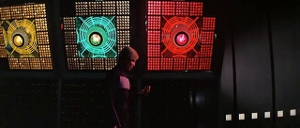
Either way, both book and film take place in a dystopian future where everyone is legally obliged to die at a certain age. Both follow a main character charged with enforcing this law who, eventually, grows to recognize its inherent injustice and aid the very rebels he’s spent his life gunning down. Both main characters are cut right out of a standard antihero mold, and if you put a gun to my head and forced me to name their nearest ancestor, I’d pick Guy Montag from Fahrenheit 451.
That’s where the similarities end and Logan’s Run-the-film dives right into its only selling point: lavish production design. What, did you think they spent those nine million dollars on script doctoring?
So in the Year of The City 2274, the remains of humanity live inside a dome, their every want and need supplied through the wall by a fantastically advanced and fucking enormous computer system. (Because that’s original.) Everyone inside MegaCity One gets thirty years to the day before the little Lifeclock jewel in their palm begins flashing. On their Lastday, The Computer calls them to Carrousel, a “fiery ritual” that’s half Circus Maximus, half Cirque du Soleil and all public execution. Who knew the word “renew” could sound so much like “Sieg Heil“? Most things do when shouted in unison by a crowd. Even this bunch of red-and-green toga wearers started to look a little intimidating…until I noticed this movie takes place in a future without bras.
Obviously some “misfits” refuse to report to Carrousel, necessitating the need for Sandmen – the black-and-gray clad enforcers of law and order who seem to do nothing but chase down Runners. Our antihero is Logan 5 (Michael York) a Sandman who likes to play with his prey. The movie contrasts our first view of Carrousel with a down-right sadistic sequence as Logan purposefully misses the Runner his aiming for. The Riggs to Logan’s Murtaugh, Francis 7 (Richard Jordan), eventually puts the poor bastard out of his misery. In the jovial afterglow of their murder, Francis insists, “I had to do something: you kept missing.”
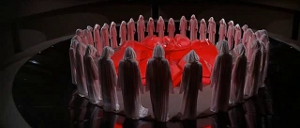
There’s nothing wrong with making your main character a murderous asshole with moral tunnel vision. If there were, whole genres of fiction would cease to exist. But I better have an easy way to get into that murdering asshole’s head or he’s just going to be another murdering asshole and I’m just going to be bored, waiting for him to complete his Hero’s Journey. There are dozens of different ways for a novel to do this – techniques film does not have, because the screen will always form a barrier between the character’s interior lives and the audience…until someone invents PsychicVision. It’s a permeable barrier, don’t get me wrong…but its a barrier you need real skill to penetrate.
And speaking of penetration: like Winston Smith (a literary ancestor of both Logan and Guy Montag) Logan’s brought around to his awakening by an open-minded lady-person he’s immediately attracted to because…well, she has breasts. Jessica 6 (Jenny Agutter) also has what her society would consider serious emotional problems – she feels loss for those “renewed” in Carrousel, accuses Logan of being a killer (“I’ve never killed anyone in my life; Sandmen terminate runners.”) and has the one Ultimate Signifier of Goodness in any Sci-Fi Dystopia: curiosity.
“Why is it wrong to run?”
“You shouldn’t even be thinking such things – let alone talking about them.”
Nice sentiment, Logan…but that’s probably the first question on any kid’s mind once they become smart enough to ask (assuming they don’t turn into feral Lords of the Flies, like the “Cubs” down in Cathedral). And if this society can crack-up under such a basic question’s weight, I start questioning how it’s lasted two hundred years.
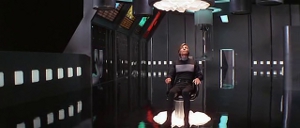
Logan completes the crack-up when The Computer informs him that one thousand fifty-six Runners are currently unaccounted for. His mission: become an undercover Runner and infiltrate the resistance group ferrying them out of The City to some legendary Sanctuary…somewhere…Completing the illusion, The Computer runs Logan’s Lifeclock down and refuses to say if he’ll get his four years back. Because that’s logical. And smart. Great way to keep your agent loyal, female Hal 9000. Anyone else want to bet this is “her” first undercover op?
You know what pisses me off the most? There’s no reason in the film to call these people “Sandmen.” It makes perfect sense in the novel, where there is no Carrousel – citizens report to conveniently located “Sleepshops,” the agents of which are called Deep Sleep Operatives…or colloquially, Sandmen. Simple, little pieces of story logic (like that) can mean the difference between SF worlds that make sense and SF worlds that were Obviously Built to Fail (like the Old Republic of the Star Wars prequels).
This City is the latter. I don’t know what kind of educational programs this thing runs, but they obviously haven’t done their jobs. Logan in particular – who’s apparently awesome enough to win himself an undercover job – seems incredibly naive about everything, to the point where his every utterance causes suspicion.
“Francis, did you…did you ever see anybody renew?”
“I think you’ve been skulling-out too much. First nursery, now silly questions.”

Well, you have to admit, Francis, you’re in an incredibly silly place: its interiors look more like a swank luxury hotel than a Domed City of the Future: ugly ultramodernism clashing with the citizen’s age-coded togas. The City’s industrial underbelly looks a bit better, but it’s still a Ken Adam-inspired collection of pipes, catwalks, staircases and stagnant pools of…something green. (Soylent Green, perhaps?) None of it looks near rusty or dank enough for my taste, though it certainly presages the “gritty” SF and “used” futures of the Star Wars and Alien. Even with that, evrything’s still too clean, too bound by its own sets.
This persists through the ice cave sequence, nice as that is for introducing the truly insane android, BOX. He is quite overwhelming and I was startled. He’s quite removed from my kin.
Logan and Jessica’s journey outside is more “whelming,” (to borrow a phrase) because here the film descends into one long sequence of Michael York and Jenny Agutter looking at things. While they have idiotic exchanges like

“What is it?”
“I don’t know…whatever it is, it’s warm.”
Or this,
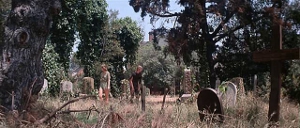
“They’ve all got names and numbers on them. I wonder what they are.”
” ‘Beloved husband’, ‘beloved wife.'” I wonder what it means.”
which is the most annoying kind of sci-fi writing, immediately putting your characters at a disadvantage. Bad enough when they’re “normal” people in some fantastical world, stopping the action every five minutes to ask someone else, “What the hell was that?” When they’re fantastical people dealing with the mundane, post-apocalyptic wreckage of our modern world, I loose any patience with them.
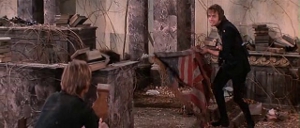
Plus this entire sequence – culminating in a whole lot of York and Agutter looking at the overgrown-but-not-bad-for-200-years-in-the-rain ruins of Washington D.C. They look at Lincoln, they look at Washington’s giant cock…and they stare slack jawed at the Crazy Old Cat Dude (Peter “he’ll always be Prince John to me” Ustinov) living in the Senate chambers and quoting T.S. Elliot to his Cat Army. For me, Ustinov is the best thing in this movie: the one thing that’s intentionally hilarious.
Plus Ustinov’s the best actor in the cast, followed closely by Richard Jordan, who clearly had fun being the Inspector Javert. In the novel, his character’s revealed to have been the leader of the resistance All This Time. Here he’s…not…which means he has no character arc whatsoever, but at least he keeps the chase moving. If it were up to York and Agutter, we’d spend the entire last hour of the film looking at things. Or falling in Movie Love, since…um…yeah…did Taylor and Nova need a reason?
This was sold to us as a Chase Film, after all. Except MGM didn’t hire the makers of chase movies. Michael Anderson’s previous two movies were about popes. (No, really.) His next movie would be…oh sweet Geezus…Orca…excuse me…
(ten minutes of shivering later)
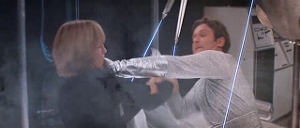
Screenwriter David Zelag Goodman helped Sam Peckinpah write Straw Dogs. I’ll pause to let that sink in, since…fucking Straw Dogs?! Who goes from Straw Dogs to this? In between, he did Farewell My Lovely, which is closer to this, in that both are adaptions of books…but still, that was Raymond Chandler. This is out there, Big Idea Sci-Fi that might’ve held actual social relevance upon its first published. It seems dated here because the people who brought it to the screen had no idea what they were doing. They were hired guns, and they did a mercenary job on this story.
Ah well. At least they hired a great production designer – Dale Hennesy, the man who made Fantastic Voyage, Young Frankenstein and Dino De Laurentiis’ King Kong look the way they do. And a great musician in Jerry Goldsmith, who plays around with synthesizers far more than he’d ever do again…though only in The City (so take heart, Jerry: at least I noticed.) Good job, there. Ernest Laszlo’s cinematography is fantastic, and his colors are only going to get brighter now that we’ve digitized his film and cleaned up the print as best we can…but you know I’m reaching when I’m praising the DP.
In the end, Logan’s Run is a stiff but colorful bit of factory-pressed cheese. No one could escape the obvious truth that they were working on a silly, silly movie and so refused to do anything strenuous, like really go for it. They hollowed out a novel in the hope that filling it would pretty things (and people) would distract us from how little thought they put into this thing…as if the initial hook of the premise could carry us past the nonsense. I suspect MGM consciously tried to create a giant SF franchise…like Fox’s Planet of the Apes…and didn’t care very much about the particulars.
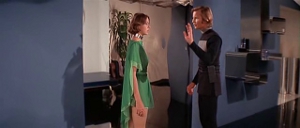
To a certain extent, it worked. Logan’s Run is one of those mass marketed Cult Classics (as opposed to actual cult classics, like The Room or Reefer Madness) that spawned its own one-season TV series and is constantly being almost remade. The director of Drive, Nicolas Winding Refn, is the latest name attached to the project and…it’ll probably suck.
I’m not saying the original sucks, but it is dull and deathly predictable…unless you’re one of those misfits who’s never read a sci-fi story before. In which case…run, Runner!
![]()
![]()
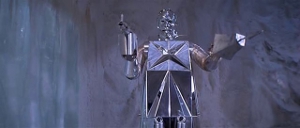

Somehow, I haven’t seen this one since I was a little kid. I remember shooting and breasts.
That’s pretty much it, though there’s not nearly as much of either as I remembered, and all of its front-loaded. Which is probably why I had such a hard time remembering the end. That and, as far as I can recall from old viewing on the pre-sell-out Sci-Fi Channel, Logan’s Run The Series pretty much ignored the ending completely. Or maybe it took place in an alternate dimension, like the third book in Logan’s trilogy. (Oh yeah – by the way – Logan’s Run is the first act of its own epic SF trilogy – look for a remake in the Not Too Distant Future, whether we like it or not.)
One of the local stations growing up showed this once or twice every few years, and I’d eagerly await it. When I watched it again in my 30s, I noticed that part of the reason I enjoyed it was that either through the magic of falling asleep while watching TV, or possibly my bedtime, I never saw much of the film past Logan and Jessica escaping. I was left with all the exciting parts and none of the “Crazy Old Cat Man is Charmingly Crazy” stuff, nor the weak, weak climax. “Come, join us! Grow old and help us rape this pristine environment! Don’t worry, only 80-95% of you are going to starve to death while we try to figure out how to live without our machines!” This accounts, I think, for my fondness for it.
I’m not sure the lack of “lived in” future is a problem in this one…it always seemed to me to be a bit of satire on the rise of mall culture, and malls rarely look run down.
This film (along with “2001 A Space Odyssey”) nearly convinced me that classic sci-fi was mostly junk. Then I saw “Forbidden Planet” and “Planet of the Apes” which redeemed the entire genre for me.
Talk about classic sci-fi, David. Another great flick for the youngsters to dig into. Been watching The Time Machine (1960, starring Rod Taylor and Alan Young) here yesterday. Any chance of that appearing on it in due course? The Guy Pearce/Samantha Mumba 2002 remake is better off not being mentioned too much.
Considering my love for H.G. Wells and George Pal, 1960’s The Time Machine will certainly be making an appearance. Simon Wells’ Time Machine might as well, provided I slip into a deep enough depression.
What I think annoyed me the most, was the fact that all the runners use an Ankh to represent their outside city of Sanctuary. Now, supposedly no one outside of the rebels has heard of Sanctuary or even knows what an Ankh is, which is odd, considering that Jessica 6 continually runs around with a freaking huge Ankh around her neck! To compound things, the rebels let her do so, even though none of them do the same!
(modified scene dialogue)
Computer: Do you identify this object Logan 5?
Logan: Negative.
Computer: That is the name of the object. It is called an ankh.
Logan: Hmm. I think I remember Jessica 6 wearing one last night, when I ordered her off my futuristic Craigslist singles.
Computer: thank you Logan 5. You are free to go, I will send for Jessica 6. (And the whole movie takes a new turn of direction)
…potentially, a direction that doesn’t end in the Bitchy Computer’s self-destruction. Of course, the entire problem of Runners reaching Sanctuary could be easily solved with a few strategically placed security cameras (instead of the “glowing dots on a map” screens the Sandmen seem to spend their day staring at).
LOL the fact that Logan’s Run is silly/nonsensical is exactly why I like it! I prefer science fiction like this because it can be boring when it’s serious (4th Doctor is better than the 11th)
Anything can get boring (including silly nonsense) if it’s poorly made, but that’s not Logan’s Run‘s problem. If anything, the flick took itself too seriously. We have to remember that pre-Star Wars age, when a restless audience’s visible boredom was an instant sign of artistic merit. I genuinely believe everyone on this film genuinely believed they were making a poignant social commentary about the follies of Youth Culture in Gerald Ford’s America. Everyone in front of the camera certainly seems to be taking this seriously. That, all by itself, generates amounts of silliness that can only be measured in metric tons, especially when you plop these serious actors inside all these funky, 70s Futurist sets.
But, again, that’s looking at it from my cynical eye, casting a backward glance at a bygone age, when those funky sets were as valid a representation of the future as Star Trek (2009)’s iPhone Store Utopia. The Serious Meditations of one generation become the hilarious distractions of another and we never can tell what will turn into what, when, where, or why. So I tend to think it’s best if creatives take their work seriously. The rest of us can do with it as we please. Because if the artists aren’t driven to distraction by their subject, I probably won’t be either…unless the artist’s apathy, greed, corruption, or outright negligence is blatantly obvious and put on full public display (See also Bay, Michael; Anderson, Paul W.S.; Snyder, Zack; careers of).
So I finally watched this movie, after hearing about it for years. One of the things I can’t figure out, is right before Logan leaves the city, it seems as though he calls in all the sandmen. Did he signal for “backup” on purpose or was it a mistake? It seemed to be on purpose, and if so, the movie really was shit – and Jessica should have shot off his balls.
He totally called them in on purpose, and right after Jessica told him he was on Candid Camera. The point of the movie (allegedly) being Logan’s reform from True Blue Company Man to Savior of the Human Race and Restorer of the Natural Order. But yeah – it’s kinda shit. And Logan 5 is totally a shit.